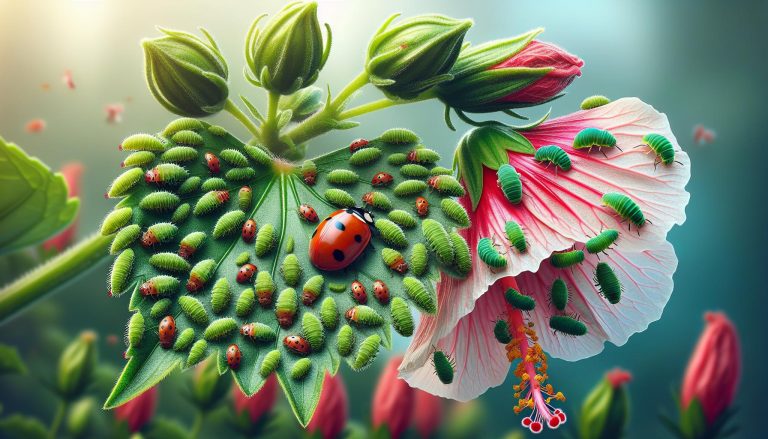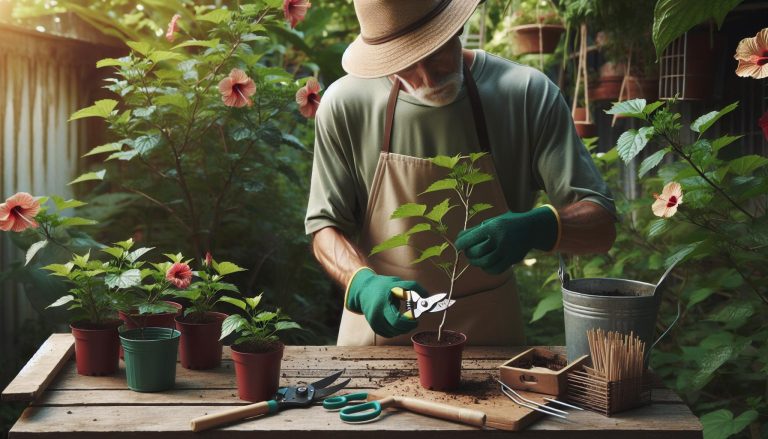How to Keep Your Hibiscus Blooming All Season Long
Hibiscus trees, with their stunning, vibrant blooms, are a joy to behold in any garden or home. From the well-loved Hibiscus rosa-sinensis to the late-blooming Hibiscus syriacus and the edible Hibiscus sabdariffa, these plants offer a dazzling array of colors and shapes. Yet, one of the most common questions we encounter is how to keep these beauties blooming. It’s a challenge many of us face, whether we’re tending to these tropical wonders in cooler northern climates or enjoying their splendor in warmer zones.
Understanding the needs of hibiscus is crucial to unlocking their full blooming potential. These plants thrive in warm, humid conditions and require plenty of sunlight to produce their signature flowers. Whether you’re growing hibiscus in containers that can be moved to catch the sun or planting them directly in your garden, the key to continuous blooms lies in meeting their specific care requirements. Join us as we explore the essential tricks and tips to keep your hibiscus blooming, transforming your space into a tropical paradise, no matter where you are.
Key Takeaways
- **Understanding Hibiscus Blooming
Understanding Hibiscus Blooming Requirements
Mastering the blooming schedule of hibiscus plants hinges on recognizing their specific growth conditions and needs. Let’s delve into the essential aspects that contribute to a flourishing hibiscus garden.
Ideal Climatic Conditions
Hibiscus plants thrive in warm, tropical climates but adapt to various environments with the right care. They require full sun exposure for at least six hours a day to bloom optimally. Areas receiving sunlight in the morning and partial shade in the afternoon provide the perfect balance, protecting plants from the harsh afternoon sun. Temperature plays a crucial role in their growth cycle. Hibiscus flowers flourish in temperatures ranging from 60 to 90 degrees Fahrenheit. While they can tolerate higher temperatures, ensuring adequate moisture and mulching can help keep the soil temperature regulated. During winter, maintaining an indoor temperature of around 55 degrees Fahrenheit facilitates continued growth, though at a slower pace. High humidity levels, mimicking tropical atmospheres, encourage lush flowering. Enhance home environments with humidifiers or place water trays near the plants to increase air moisture content around your hibiscus.
Understanding Different Hibiscus Varieties
The blooming potential of hibiscus also depends on the variety being cultivated. The two primary variants include the tropical hibiscus (Hibiscus rosa-sinensis) and the hardy hibiscus (Hibiscus syriacus and others). The tropical hibiscus, true to its name, favors warm climates and consistently produces vibrant blooms year-round in USDA zones 9 to 11. This variety necessitates protection from cold temperatures and may require indoor shelter in winter in temperate zones. The hardy hibiscus, on the other hand, withstands colder temperatures down to USDA zone 4. It enters a period of dormancy in winter, with the foliage dying back, but it vigorously returns in spring to showcase its large, stunning flowers. Understanding these differences ensures correct care approaches are applied, catering to each hibiscus type’s unique needs for sunlight, temperature, and winter protection. Our gardening strategies should align with these necessities to stimulate and sustain their impressive bloom cycles.
Selecting the Perfect Location

Choosing the right spot for a hibiscus is crucial. It not only influences growth but directly impacts blooming frequency and quality.
Sunlight Needs
Hibiscus plants crave sunlight, demanding a minimum of six hours of direct exposure daily. This requirement is non-negotiable if the goal is vibrant, continuous blooms. Inadequate sunlight results in lush foliage without flowers. To optimize blooming, position your hibiscus in a location that meets this sunlight quota. Should your plant receive less light due to unforeseen changes, like the growth of trees or construction that casts new shadows, moving the hibiscus to a brighter spot becomes essential. Relocation allows the plant to meet its photosynthesis needs, translating into more flowers.
Soil Quality
The next critical factor in ensuring a hibiscus blooms beautifully is soil quality. Hibiscus prefers well-drained soil rich in organic matter. Before planting, mix in ample compost to enhance the soil’s fertility and drainage capabilities. This step not only nourishes the plant but promotes robust root development, laying the foundation for healthy growth and blooming. Hibiscus plants also respond well to slightly acidic to neutral pH levels. If unsure about your soil’s pH, conducting a test provides valuable insights, enabling adjustments, if necessary, to create the optimal growing environment. Well-prepared soil, combined with proper sunlight, sets the stage for a hibiscus to thrive and bloom abundantly.
Proper Planting Techniques

Adhering to proper planting techniques ensures that hibiscus plants set a solid foundation for vibrant, long-lasting blooms. Through attention to detail during the planting process, we create the optimal conditions for hibiscus growth.
Best Time to Plant
The ideal time for planting hibiscus varies depending on the type. Plant perennial hibiscus in spring, right after the last frost, to give them a full growing season to establish. For tropical hibiscus, late spring or early summer is perfect, once the threat of cold weather has passed. This timing ensures that the plants have ample warmth and sunlight to thrive from the outset.
Planting Depth and Spacing
Planting depth is crucial for the health of hibiscus plants. Dig a hole twice as wide and just as deep as the root ball. This ensures roots have room to spread without being too deep, which could cause waterlogging and root rot. For spacing, position hibiscus plants at least 2 to 3 feet apart. This spacing accommodates their growth and ensures adequate air circulation, which reduces the risk of disease. Adjust spacing for larger varieties, allowing more room for expansion.
Watering Your Hibiscus Correctly

Proper hydration plays a crucial role in keeping your hibiscus plants blooming. Understanding the balance between over and under-watering can ensure your hibiscus thrives.
Signs of Over and Under-Watering
Monitoring your hibiscus for signs of water distress is essential. Leaves turning yellow and dropping are common indicators of over-watering. This condition may lead to root rot, severely impacting the plant’s health and bloom potential. Conversely, leaves that appear dry, wilted, or crispy signify under-watering. Hibiscus plants demand consistent moisture, especially during their blooming phase. If the top inch of the soil feels dry, it’s time to water your plant.
Mulching to Retain Moisture
Applying mulch around your hibiscus not only retains soil moisture but also regulates soil temperature. Use organic materials like shredded bark, straw, or wood chips for mulching. A layer of about 1 inch for indoor plants and 3 inches for those outdoors proves beneficial. Mulch helps in maintaining consistent moisture levels, reducing the frequency of watering, and providing a conducive environment for continuous blooms. It’s a simple yet effective strategy to ensure your hibiscus flowers throughout the season.
Feeding Your Hibiscus for Optimal Blooms

Ensuring our hibiscus plants are properly fed is crucial for achieving vibrant and long-lasting blooms. The right fertilization strategy not only boosts bloom production but also enhances the plant’s overall health.
Choosing the Right Fertilizer
Selecting an appropriate fertilizer for our hibiscus plants lays the foundation for their blooming success. A slow-release fertilizer with a balanced ratio of nitrogen, phosphorus, and potassium (NPK), such as a 14-14-14 blend, suits hibiscus plants well. Phosphorus, the middle number in the NPK ratio, is particularly important for encouraging strong and abundant blooms. Moreover, supplements containing iron and magnesium prove beneficial, promoting lush foliage and vibrant flower colors. Ensure the fertilizer product does not contain too much phosphorus, as excessive amounts can harm the plant.
When and How to Fertilize
Fertilizing our hibiscus plants follows a seasonal rhythm, aligning with their growth and blooming cycles. During the growing season, from spring through fall, fertilize the plants every two weeks. This schedule supports continuous growth and blooming. Utilize a water-soluble fertilizer to ensure nutrients are readily available to the plant. Dissolve the prescribed amount in water, applying this solution to the soil around the plant. This method helps to distribute nutrients evenly, promoting uniform growth and blooming.
In contrast, winter months require a different approach, as hibiscus plants enter a dormant phase. Cease fertilization during winter, allowing the plant to rest. Resuming the fertilization schedule in early spring encourages a vigorous restart to the growing season, leading to abundant blooms.
By following these guidelines in choosing the right fertilizer and understanding when and how to fertilize, we create an optimal environment for our hibiscus plants to thrive and bloom spectacularly.
Pruning for Healthier Blooms
Pruning plays a critical role in encouraging hibiscus plants to produce stunning, healthier blooms. By understanding the proper timing and techniques, gardeners can significantly enhance their hibiscus’s flowering potential.
When to Prune
Spring emerges as the prime time for pruning hibiscus. Just as days lengthen and temperatures begin to rise, gardeners should inspect their plants for signs of new growth. This period allows hibiscus plants ample time to recover from pruning and develop buds for the blooming season ahead. It’s essential to refrain from winter pruning, as this can hinder the plant’s natural dormancy phase and its ability to withstand cold temperatures.
For hibiscus not blooming or showing sparse growth, a more aggressive pruning early in the spring can stimulate vigor and encourage blooms. In such cases, removing up to a third of the mature plant may be necessary to rejuvenate and prompt flowering.
Pruning Techniques
Effective pruning hinges on using clean, sharp tools to make precise cuts. This ensures rapid healing and reduces the risk of infection. During the pruning process, our focus should include:
- Removing any dead or diseased branches to improve plant health and appearance. These cuts should be close to the trunk or main branches to avoid leaving stubs that could attract pests and diseases.
- Thinning out crowded areas within the plant to enhance air circulation. This step is crucial for preventing fungal diseases and ensuring light reaches the inner parts of the plant.
- Shaping the hibiscus to maintain its overall structure and beauty. While shaping, aim to create an open, vase-like form that facilitates balanced growth and access to sunlight.
- Cutting back leggy branches by one-third to one-half, depending on the plant’s condition and your desired results. This stimulates new growth from the base and can lead to more prolific blooming.
Incorporating these pruning techniques, especially after establishing a robust feeding schedule, positively impacts the hibiscus plants’ bloom production. By diligently following these steps, we set the stage for our hibiscus to exhibit their full flowering potential.
Pest and Disease Management

Following our guidance on feeding and pruning, ensuring effective pest and disease management solidifies the road to vibrant, long-lasting hibiscus blooms. Awareness and timely action can make all the difference.
Common Issues to Watch For
Our hibiscus plants face threats from a variety of insect pests and diseases. Aphids, Japanese beetles, thrips, mealybugs, whiteflies, and scale rank as the most prevalent pests, each capable of hindering plant growth and bloom production. Diseases such as Armillaria root rot, Botrytis blight, leaf spots, and Hibiscus chlorotic ringspot virus also pose significant risks. While most hibiscus varieties prove non-toxic to pets, the Rose of Sharon (Hibiscus syriacus) is an exception, causing gastrointestinal distress in dogs and cats alike.
Prevention and Treatment
Preventive measures enhance a hibiscus plant’s resistance to pests and diseases. Ensuring proper air circulation, adequate sunlight, and optimal watering practices helps in keeping hibiscus plants healthy and less susceptible to issues. Regular inspection of the plant for signs of pest activity or disease is essential for early detection and treatment. For pest control, horticultural oil or insecticidal soap offers a non-toxic solution if applied promptly upon detection. In cases of disease, removing affected areas and applying appropriate fungicides as per the specific diagnosis can help manage the spread.
Implementing these pest and disease management strategies, along with the feeding and pruning practices previously outlined, supports the health and blooming of hibiscus plants. By recognizing and addressing potential threats early, we ensure our hibiscus remains a stunning focal point in any garden.
Encouraging More Blooms
To ensure our hibiscus plants not only grow but thrive and burst into a spectacle of blooms, specific care steps are essential. Our focus here is to introduce methods that directly contribute to enhancing flower production.
Deadheading and Timely Pruning
Deadheading, or the removal of faded or spent flowers, significantly encourages new blooms on a hibiscus plant. By removing these flowers, we direct the plant’s energy towards producing new blooms rather than seeding. Pruning plays a crucial role in not only maintaining the shape and size of the plant but also promoting a bushier growth with more blooms. For tropical hibiscus, a pruning of up to one-third during the active growing months of summer keeps the plant in optimal condition for blooming. On the other hand, perennial hibiscus requires pruning in the spring once new sprouts appear. Cutting back the new growth by about one-third after the first bloom can stimulate a second flush of flowers during the summer.
Proper Watering Techniques
While hibiscus plants demand consistent hydration, overwatering or under-watering can significantly affect their blooming capacity. We ensure to water the plants thoroughly, allowing the soil to become markedly moist but not waterlogged. During the peak growing seasons, maintaining a consistent watering schedule prevents stress on the plants, facilitating continuous bloom production. As seasons shift and temperatures drop, reducing the frequency of watering aligns with the plant’s natural growth cycle and prepares it for dormancy.
Using Epsom Salt for Healthier Plants
Incorporating Epsom salt into our hibiscus care routine offers a simple yet effective way to boost plant health and flower production. Epsom salt, comprised of magnesium and sulfate, two nutrients vital for plant growth, enhances the uptake of essential nutrients like nitrogen, phosphorus, and potassium. We dissolve 2 tablespoons of Epsom salt in a gallon of water and apply it monthly as a foliar spray or directly to the soil. This solution promotes more vibrant blooms, higher yields, and improves the overall foliage color of the hibiscus, making them a dazzling feature in our gardens.
Winter Care for Tropical Hibiscus
Tropical hibiscus plants thrive in warm conditions yet require special care during the colder months to keep blooming. In this section, we explore how to protect these vibrant beauties through winter, focusing on overwintering indoors and the necessary temperature and light adjustments.
Overwintering Indoors
Transitioning tropical hibiscus plants indoors for the winter is crucial for their survival and continued blooming. Begin this process before the first frost by conducting a thorough inspection for pests and treating any infestations to prevent indoor spread. Gradually acclimate your hibiscus to lower light conditions over a few weeks to reduce shock. Once indoors, place the plant in a well-lit area, preferably near a south-facing window, to maximize exposure to natural sunlight. Regularly check soil moisture, as indoor heating can rapidly dry out the potting mix. Aim to keep the soil consistently moist but not waterlogged. Trimming back the hibiscus by about one-third helps manage its size and encourages healthier growth and bloom production when returned outdoors.
Temperature and Light Adjustments
Maintaining appropriate temperature and light levels is essential for the health of indoor overwintering tropical hibiscus. These plants prefer daytime temperatures between 65°F and 70°F and slightly cooler temperatures at night, around 55°F to 60°F. Such conditions mimic their natural tropical environment, reducing stress and promoting better health. Ensure the plant receives at least six hours of direct sunlight daily; if natural light is insufficient, consider using grow lights to supplement. Positioning the hibiscus away from cold drafts and heating vents will also prevent leaf drop and desiccation. By adjusting temperature and light to these specifications, we offer our tropical hibiscus the best chance to survive the winter months healthily, ready to bloom beautifully again come spring.
Troubleshooting Common Issues
Encountering problems with hibiscus care can be discouraging, but most issues are easily diagnosable and solvable. This section provides effective approaches to common challenges, ensuring your hibiscus continues to thrive and bloom beautifully.
Lack of Blooms
Optimal sunlight and diligent pest control stand out as key elements in resolving a hibiscus’s lack of blooms. Hibiscus plants demand at least 6 hours of direct sunlight daily to produce their signature vibrant flowers. Insufficient light directly impacts their blooming capacity. To rectify this, relocate your plant to a sunnier spot, ensuring it receives the full spectrum of natural light it craves for blooming. In addition, pests like aphids and spider mites siphon vital nutrients from the plant. Regularly inspect leaves, stems, and the soil for pest activity. Applying a gentle horticultural oil or neem oil spray helps in eradicating these pests, consequently encouraging the plant to focus its energy on producing blooms rather than fighting infestations.
Yellow Leaves
Proper watering and addressing overwatering are crucial for correcting yellow leaves. Hibiscus plants require consistent moisture, but they do not cope well with waterlogged soil. Yellow leaves often signal overwatering or poor drainage, leading to root rot, which prevents the plant from absorbing necessary nutrients. Adjust your watering schedule according to the plant’s needs and the weather conditions, ensuring the soil remains moist but not saturated. Additionally, confirm that your potting mix is well-draining and the container has sufficient drainage holes. If overwatering has occurred, replace the soil with fresh, well-draining potting mix and reduce watering frequency. Monitoring these conditions closely will help restore the lush green color of your hibiscus leaves, promoting overall health and vitality.
Conclusion
We’ve journeyed through the essential steps to keep our hibiscus blooming brilliantly. From the right planting techniques and hydration to the importance of feeding, pruning, and disease management, we’ve covered it all. Remember, the secret lies in consistent care and understanding the unique needs of your hibiscus plants. By following our guide, you’re well on your way to enjoying vibrant blooms that’ll make your garden the envy of the neighborhood. Let’s embrace these practices and watch as our hibiscus plants thrive, bringing a burst of color and life to our outdoor spaces. Happy gardening!
Frequently Asked Questions
Do coffee grounds help hibiscus?
Coffee grounds can benefit hibiscus plants by providing nutrition and acidity, promoting health and growth. However, excessive use may lead to negative effects such as legginess or bacterial growth.
How do you keep a potted hibiscus blooming?
For a potted hibiscus to bloom, it requires ample sunlight. Position it in a location with at least 6 hours of direct sunlight daily. In hotter climates, some afternoon shade is beneficial.
How do you keep hibiscus buds from falling off?
To prevent hibiscus buds from falling off, use a product like Ortho Rose and Flower Insect Killer, targeting the flower bud midge and caterpillar larvae which are common culprits.
How do I keep hibiscus blooming all summer?
Encourage continuous summer blooming by deadheading spent blooms and removing dead or discolored leaves from your hibiscus plants to promote healthier, more vigorous growth.
What does Epsom salt do for hibiscus?
Epsom salt (magnesium sulfate) can improve the foliage color of hibiscus plants, contributing to a darker green appearance. It’s beneficial when used alongside a high bloom water-soluble fertilizer.







